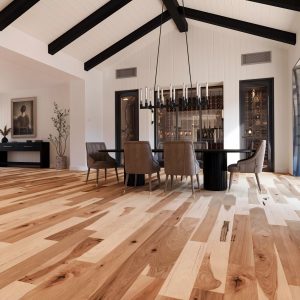Rustic hickory flooring brings a unique blend of natural beauty and durability to any home. Known for its distinctive grain patterns and warm tones, this hardwood option transforms spaces with timeless charm. This article explores the appeal, installation, maintenance, and design possibilities of rustic hickory flooring, offering insights for homeowners seeking a blend of style and functionality.

Why Choose Rustic Hickory Flooring?
Rustic hickory flooring stands out for its bold, natural aesthetic. The wood’s varied grain, knots, and color variations—ranging from creamy whites to deep browns—create a warm, inviting look. Unlike uniform hardwoods, hickory’s rugged charm suits both modern and traditional interiors.
Durability and Strength
Hickory is one of the hardest domestic hardwoods, ranking high on the Janka hardness scale at around 1,820. This makes it ideal for high-traffic areas like living rooms or kitchens, resisting dents and scratches better than softer woods like pine.
Unique Aesthetic Appeal
The natural imperfections, such as knots and mineral streaks, give each plank a one-of-a-kind character. This variability allows homeowners to create floors that feel authentic and lived-in, perfect for cozy or farmhouse-style homes.
Installation Process for Rustic Hickory Flooring
Installing rustic hickory flooring requires careful planning to ensure a flawless finish. Whether choosing solid or engineered hickory, the process involves several key steps to achieve a professional result.
Preparing the Subfloor
Start with a clean, level subfloor. Remove any debris, check for moisture, and ensure the surface is flat. For concrete subfloors, a moisture barrier may be necessary to prevent warping.
Acclimation and Layout
Allow hickory planks to acclimate to the room’s temperature and humidity for 48-72 hours. Plan the layout to balance the wood’s natural variations, ensuring an even distribution of colors and patterns.
Installation Techniques
Nail-down, glue-down, or floating methods can be used, depending on the floor type. Solid hickory typically requires nailing, while engineered hickory offers more flexibility. Always follow manufacturer guidelines for best results.
Maintaining Rustic Hickory Flooring
Proper care extends the life and beauty of rustic hickory floors. Regular maintenance keeps the wood looking vibrant while protecting its durability.
Routine Cleaning
Sweep or vacuum weekly to remove dirt and grit. Use a damp mop with a hardwood-safe cleaner, avoiding excess water to prevent damage. Dry immediately to maintain the finish.
Preventing Damage
Place rugs in high-traffic areas and use furniture pads to avoid scratches. Control indoor humidity between 35-55% to prevent expansion or contraction, especially in humid climates.
Refinishing for Longevity
Rustic hickory can be sanded and refinished multiple times, refreshing its appearance. Every 5-10 years, consider professional refinishing to restore luster and repair minor wear.
Design Ideas with Rustic Hickory Flooring
Rustic hickory’s versatility makes it a favorite for diverse interior styles. Its natural tones pair well with various color palettes and decor themes.
Farmhouse and Rustic Interiors
Combine hickory floors with exposed beams, neutral walls, and vintage furniture for a cozy farmhouse look. Add textured rugs to enhance warmth and comfort.
Modern and Minimalist Spaces
Pair hickory with sleek furniture and bold accents for a contemporary twist. A matte finish emphasizes the wood’s natural beauty while keeping the look clean and modern.
Eclectic and Bold Designs
Use hickory as a neutral base for vibrant decor. Mix with colorful walls or patterned textiles to create a dynamic, eclectic space that feels personal and inviting.
Environmental and Cost Considerations
Rustic hickory flooring is both eco-friendly and cost-effective when sourced responsibly. Understanding its environmental impact and pricing helps homeowners make informed decisions.
Sustainability Factors
Hickory is abundant in North America, and many suppliers offer FSC-certified options. Choosing locally sourced wood reduces transportation emissions, supporting eco-conscious home projects.
Cost and Value
Rustic hickory typically costs $5-$10 per square foot, depending on grade and finish. While pricier than some hardwoods, its durability and timeless appeal offer excellent long-term value.
Rustic hickory flooring combines durability, beauty, and versatility, making it a top choice for homeowners. With proper installation and care, it elevates any space, offering lasting value and charm. Whether aiming for a rustic retreat or a modern haven, hickory delivers a floor that’s as functional as it is stunning.




